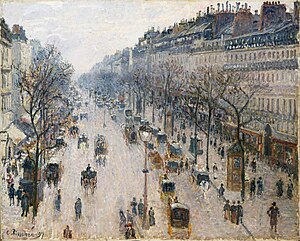Boulevard Montmartre on a winter morning

|
| Le Boulevard Montmartre, matin d'hiver |
|---|
| Camille Pissarro , 1897 |
| Oil on canvas |
| 64.8 x 81.3 cm |
| Metropolitan Museum of Art , New York |
The painting Le Boulevard Montmartre, matin d'hiver ( Boulevard Montmartre on a winter morning ) is a painting by Camille Pissarro from 1897 and shows the Boulevard Montmartre in Paris . It comes from a time when the painter had already moved away from impressionism and pointillist painting techniques. The picture belongs to a series that shows the Parisian Boulevard Montmartre in different seasons and in different light with 14 works . Today it is part of the collection of the New York Metropolitan Museum of Art , which was presented in 1960 as a gift from the art collector Katrin S. Vietor in the loving memory of her husband Ernest G. Vietor.
History and picture content
After Pissarro repeatedly painted landscapes without the ingredients of the industrialized world in the rural idyll in Éragny, north-west of Paris, in accordance with the anarchist-influenced belief in a rural ideal that was widespread among artists at the time, he moved back to Paris. In those years, Pissarro suffered from an eye disease that restricted working outdoors, so he painted his cityscapes of the boulevard from the window of his room in what was then the Grand Hotel de Russie . Pissarro wrote to his son Lucien that he believed that his gallery owner and art dealer Paul Durand-Ruel might be interested in a series of Parisian cityscapes, especially since the series of paintings by Claude Monet , such as the Haystack series , sold well.
The painting has the format 64.8 × 81.3 cm and is executed in the technique of oil on canvas . Signature and date are lower left: C. Pissarro. 97 . It shows the boulevard in a perspective composition with a vanishing point in the upper left third of the picture surface. The street layout describes a slight curve to the left. Numerous figures, carriages and omnibuses populate the wintry scenery of the city. The low population of plane trees on the street shows that the planting was not long ago, Paris was completely redesigned in the middle of the 19th century. The rows of windows in the uniform façade elements, the sidewalks furnished with kiosks and advertising pillars, and street lamps arranged in the middle convey a distant perspective overview of the perfect urban metropolis of the time from the painter's elevated point of view. A light gray, loosely cloudy sky bathes the cityscape in a bright, diffuse light.
Web links and literature
- Metropolitan Museum of Art, New York
- Impressionist and Post-Impressionist Paintings in the Metropolitan Museum of Art (Google Books)
Individual evidence
- ↑ Angela Schneider, Anke Daemgen, Gary Tinterow (eds.): French masterpieces of the 19th century from the Metropolitan Museum of Art exhibition catalog, Berlin 2007, p. 186 u. 188 f.
- ^ Charles S. Moffett: Impressionist and Post-Impressionist Paintings in the Metropolitan Museum of Art , New York 1985, p. 98
- ↑ Rolf-Ulrich Kunze: Close Readings - Cultural-historical interpretations of images of scientific-technical civilization , Karlsruhe Studies Technology and Culture, Volume 7, Karlsruhe 2014, p. 248 ff.